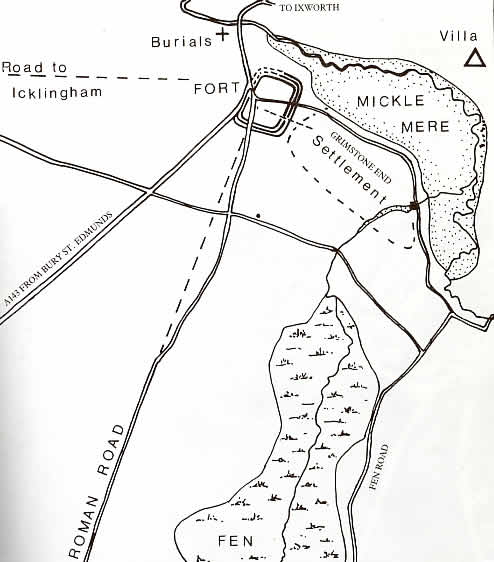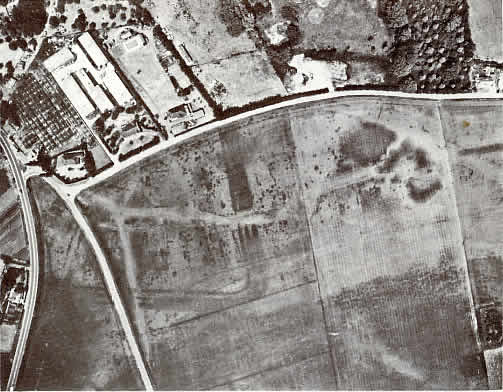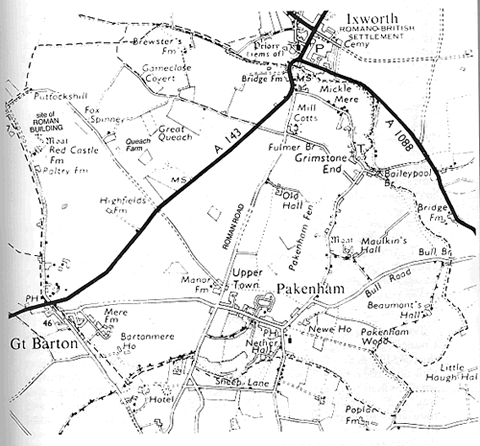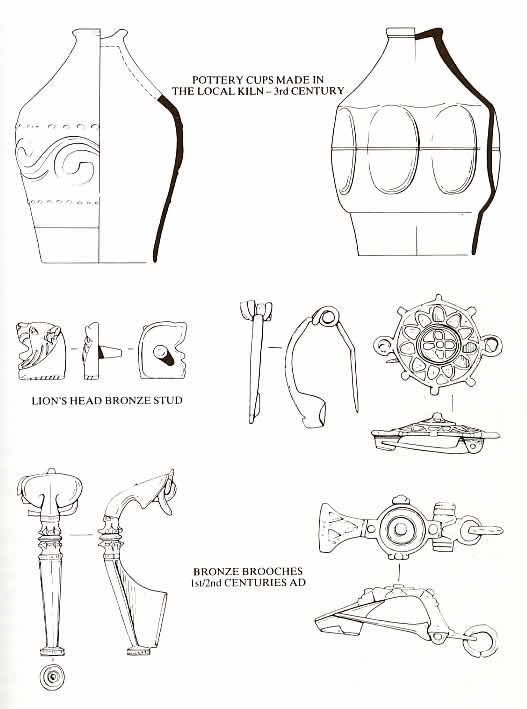Pakenham History : Pakenham-Village of Two Mills - NR Whitwell
A book written by N.R. Whitwell
with permission kindly given by S. Whitwell to publish on
the Pakenham -Village web site.
| Front Cover | Contents | Acknowledgements | Foreword | Introduction | |||||||
| C1 | C2 | C3 | C4 | C5 | C6 | C7 | C8 | C9 | C10 | C11 | C12 |
| App I | App II | App III | Epilogue | ||||||||
The earliest discernible human presence in the area now covered by the parish of Pakenham is that of some Mesolithic hunter-gatherers who were active about six to seven thousand years ago. Flint tools used by them have been found to the north of Barton Mere and in Bull Field. These Mesolithic hunters probably overlapped in time with the agriculturalists of the Neolithic period, who first arrived on the scene about five to six thousand years ago. Their flint tools have also been found to the north of Barton Mere and a piece of Neolithic pottery has
This straddles the Great Barton-Pakenham parish boundary and fluctuates in size with the seasons. At times it is the smallest of pools, surrounded by mud and reeds. At other times the water will cover ten acres, flooding the road and compelling the occupants of a nearby cottage to flee upstairs. It is said
The bed of the mere was explored in the drought of 1868 by the Revd. Harry Jones of Bartonmere House. In the course of his explorations, Mr. Jones found the remains of some wooden stakes in the mere bed and old workmen remembered finding other stakes in the mere during an earlier drought some thirty years before. The famous Neolithic lake-dwellings in Switzerland had only recently been discovered at that time and so it was inevitable that the Barton Mere stakes should have been interpreted at the remains of similar pile-dwellings. In his writings, Mr. Jones himself was very sceptical that his findings were in fact the remains of pile-dwellings. On balance it seems likely that the stakes were relatively modern, but undoubted pre-historic finds were made in the mere, suggesting that there was some sort of Neolithic settlement in its vicinity. A Bronze Age spearhead was also discovered in the mere and other bronzes are reputed to have been found there. These might have been accidental losses in the course of hunting. However, Bronze Age metal work is frequently found in wet deposits (rivers, meres, bogs etc.), often in quite large quantities, which suggests that some of this metal work may have been deliberately deposited in the water, perhaps for ritualistic reasons, rather
The ploughed-out remains of a burial mound or round barrow of the Bronze Age (dating from about 1500-2000 BC) were excavated at Grimstone End in 1954. The primary burial in this barrow was probably a cremation, accompanied by a pottery vessel; occupying subsidiary positions in the barrow were the inhumed remains of two men and a woman. During the Roman period this barrow was re-used and eight cremations, some in urns, were buried in the ditch surrounding the barrow, Later still, part of this ditch seems to have been incorporated into a sunken-featured building of Anglo-Saxon date (such as has been reconstructed at West Stow). Clay loom-weights and hearths were found associated with this building. All the finds from this excavation
Other ploughed-out barrows are known (from aerial reconnaissance) to have existed nearby. However,
Few traces of Iron Age occupation of Pakenham have, as yet, been discovered. Two silver coins minted by the British tribe known as the Iceni at about the time of the Roman Conquest of Britain (43 A.D.) have, however, been found in the parish. One of the coins is inscribed with the name Antedios, who is thought to have been one of the last rulers Iceni.
The most spectacular site of the Roman period in Pakenham is the fort which lies buried in the fields near the junction between the A143 and the Grimstone End road, just outside Ixworth. This tripple-ditched fort was identified from the air in 1945 but has never been properly excavated. The fort was probably built by the Roman army, following the suppression of the uprising by Queen Boudicca (popularly, but erroneously, known as Boadicea) and her Icenian tribesmen, c.61 A.D. There are indications that the Roman revenge for the sacking of Colchester, London and Verulamium by the British was severe and the fort at Pakenham was probably one of a number just outside the territory of the Iceni built to prevent further flare-ups of trouble.

Site of Roman Fort
There were no further revolts by the Iceni and it seems likely that the garrison was withdrawn from the fort by the end of the 1st century A.D. The area of the fort then appears to have been covered by a sprawling civilian settlement which stretched down to Grimstone end and across the river into Ixworth. This settlement probably owed its beginning to various camp-followers who established their dwellings outside the walls of the fort. In time the settlement grew large enough to survive without the fort and probably functioned as a minor market centre. On its eastern side, at Grimstone End, there appears to have been an industrial area with at least three pottery kilns. Many finds of pottery and metalwork have been made over the years at the site of this settlement. At its fringes, there is evidence of several burials.

Roman Road
A Roman Road, probably built to service the fort, runs up from the south of the parish, through Upper Town and on towards the fort. Another Roman Road is thought to have come into the parish from the west, past Puttockshill, most likely from Icklingham. There is also a junction in the fields of the Queach Farm showing quite clearly the two roads leading to the west, the other branching off to Redcastle This "Y" is seen in the springtime after the cultivations have been completed but before the crop emerges.

The Parish Of Pakenham (parish boundaries: -----)
The farm lying on the west side of the Parish commemorates in its name a long vanished Roman villa (a superior kind of Roman farm), the name relating to the end of the red Roman tile and brick found in the adjoining fields. A tessellated (mosaic) pavement was found here before 1813 and was exposed for the delight of the local gentry; however, one night cows got into the enclosures containing the pavement and broke it up. Excavations by Basil Brown in 1952 and by R.R. Inskeep in 1953 revealed a winged building of Roman date. One of the wings of this building had an apsidal recess and contained a circular multi-coloured tessellated pavement. This villa appears to have been occupied until the 4th century A.D.
The occupants of the civilian settlement near the fort - and probably of the villa as well - were not Romans from Italy but were the descendants of the Iron Age: inhabitants of the area who had adopted (to varying degrees) the Roman way of life. A new group of people, the Anglo-Saxons (Germanic tribes), began to arrive in the area from about the end of the 4th century A.D. onwards. In time their language replaced that of the Roman-British inhabitants, who may themselves have been replaced by the new settlers.
An early Anglo-Saxon settlement site is known to have existed at Grimstone End and was partially excavated by Basil Brown and others in 1953. Artefacts of a similar date have also been found in Pakenham Village and near Redcastle Farm. Pakenham and Grimstone End both bear Anglo-Saxon names and both settlements almost certainly date back to the Anglo-Saxon period, if not before.
Before the recent Ixworth bypass was constructed, the Suffolk County Council Archaeological Unit, supervised by Judith Plouviez, excavated along the road line across the fort. The fort was shown to have been used for a short time after the revolt of Boudicca (Boadicea) in A.D. 60, after which it became a small town with timber buildings and gravel roads. When the area was "dug", over 1000 coins were found, also 100 brooches, iron tools and thousands of pieces of pottery, showing that this was a flourishing local market town, complete with industry and which lasted throughout the 350 years of Roman rule. The oldest coin bears the head of Trajan (A.D.98-117) - perimeter lettering IMP.C/AES.NERVAE.TRIANO.AUG.GER.DAC.P.M.TRP.COS and "Victory" on the reverse, facing a pile of arms. The smallest clearly shows the helmeted head of Constantine I (A.D. 307-337).

Sketches of some of the finds from excavations at Pakenham





